new posts in all blogs
Viewing: Blog Posts Tagged with: picture books for older readers, Most Recent at Top [Help]
Results 1 - 25 of 126
How to use this Page
You are viewing the most recent posts tagged with the words: picture books for older readers in the JacketFlap blog reader. What is a tag? Think of a tag as a keyword or category label. Tags can both help you find posts on JacketFlap.com as well as provide an easy way for you to "remember" and classify posts for later recall. Try adding a tag yourself by clicking "Add a tag" below a post's header. Scroll down through the list of Recent Posts in the left column and click on a post title that sounds interesting. You can view all posts from a specific blog by clicking the Blog name in the right column, or you can click a 'More Posts from this Blog' link in any individual post.
Echo Echo: Reverso Poems About Greek Myths. Marilyn Singer. Illustrated by Josee Masse. 2016. 32 pages. [Source: Library]
First sentence: Ancient Greece: an age of marvelous myths, gone, but not forgotten. Heroes that rise and fall.
Premise/plot: This is the third collection of reverso poems by Marilyn Singer. The first two were: Mirror, Mirror and Follow, Follow. Both of those were fairy tale inspired poetry collections. This third book is inspired by Greek mythology.
So what is a reverso poem? A poem that is both read top to bottom, and bottom to top. The two 'versions' of the poem might tell completely different stories! Word order and punctuation can accomplish a LOT. Much more than I ever thought about!!! Most of the reverso poems in this collection have two narrators. For example, with "King Midas and His Daughter," the first poem is from the daughter's perspective (top to bottom), and the second poem (bottom to top) is from the King's perspective.
My thoughts: I really enjoyed this one. I'm not sure I loved, loved, loved it as much as the previous volumes. But. It's been a few years since I've read them, and, I'd have to reread all three closer together to truly decide which is my favorite. I can tell you that I do like Greek mythology. (Thanks in small part to Edith Hamilton and good old Percy Jackson.)
I think my favorite poem might be "Pygmalion and Galatea."
Wondrous!/ How/ life-/ like! There is nothing in this world/ so perfect. Oh, these lips, hands, eyes!/ The artist/ is in love with/ his creation./ Let a heartfelt wish be granted,/ kind Venus:/ Only you could make this stone breathe!
Only you could make this stone breathe!/ Kind Venus/ let a heartfelt wish be granted./ His creation/ is in love with/ the artist./ Oh, these lips, hands, eyes--/ so perfect!/ There is nothing in this world/ like/ life! How/ wondrous!
*The book does have at least one typo. And I wouldn't have noticed it if I hadn't chosen to share it. I would have just auto-corrected in my head without thinking twice. "There is nothing is this world." I include it here just in case it hasn't been caught yet and fixed already for future editions.
© 2016 Becky Laney of
Becky's Book Reviews
Six Dots. Jen Bryant. Illustrated by Boris Kulikov. 2016. Random House. 40 pages. [Source: Review copy]
First sentence: On the day I was born, Papa announced me to the village: "Here is my son Loo-Wee!"
Premise/plot: Six Dots is a picture book biography of Louis Braille. It is probably best for older readers because there is a lot of text.
Here's one of my favorite quotes, "I didn't want people to feel sorry for me. I just wanted to read and to write on my own, like everyone else."
The end papers include the braille alphabet, just not in braille. (It would have been great fun if the braille alphabet and the quote by Helen Keller, "We the blind, are as indebted to Louis Braille as mankind is to Gutenberg." had actually been in braille so readers--of all ages--could feel Braille for themselves.)
My thoughts: I liked this one. It is a very personal, compelling story.
Text: 4 out of 5
Illustrations: 4 out of 5
Total: 8 out of 10
© 2016 Becky Laney of
Becky's Book Reviews
Will's Words: How William Shakespeare Changed The Way You Talk. Jane Sutcliffe. Illustrated by John Shelley. 2016. Charlesbridge. 40 pages. [Source: Library]
First sentence: Dear Reader: We have to talk. I have failed you. I set out to write a book about the Globe Theatre and its great storyteller, William Shakespeare. About how the man was an absolute genius with words and wove those words into the most brilliant and moving plays ever written. But that's just the trouble. You see, I wanted to tell you the story in my own words. But Will Shakespeare's words are there, too, popping up all over the place. It's not my fault. Really. Will's words are everywhere. They're bumping into our words all the time, and we don't even know it.
Premise/plot: Sutcliffe's picture book for older readers does a great job introducing readers to the sixteenth century theatre. And her emphasis on "Will's Words" shows the relevance Shakespeare still has in today's world. It is part narrative. But on each spread, she focuses on words--phrases--Shakespeare either invented himself (coined) OR kept alive (sustained) through the longevity of his plays. She uses the word or phrase in her narrative, and then explains it. Each word is explained and/or defined. Sometimes this includes "what it meant then, what it means now." But she also always includes: WHERE it came from--which play, which act, which scene.
Words include:- for goodness' sake
- what's done is done
- too much of a good thing
- outbreak
- excitement
- of a sudden
- wild goose chase
- fashionable
- money's worth
- hurry
- with bated breath
- a sorry sight
- heart's content
- well behaved
- send him packing
- good riddance
- love letter
- laugh oneself into stitches
- foul play
- make your hair stand on end
- cold-blooded
- hot-blooded
- bloodstained
- dead as a doornail
- seen better days
- into thin air
- amazement
- the short and long of it
- not budge an inch
- eaten out of house and home
- green-eyed monster
- household words
My thoughts: I really loved this one. It is for older readers. I don't think the typical preschooler is going to care about the word origin of the phrase "dead as a doornail." But for older students (mid-to-upper elementary on up) what a treat!!! Be sure to watch the Horrible Histories music video about Shakespeare! © 2016 Becky Laney of
Becky's Book Reviews
 Time to define my terms again!
Time to define my terms again!
This is undoubtedly the most subjective of all my lists. Basically, what I’m saying with it, is that picture books are far more wide-ranging than many people suspect. If you say “picture book” they’ll imagine something for a 4-year-old. Nothing wrong with picture books for 4-year-olds, of course, but picture books hit a great swath of ages and intellects. Some really aren’t for little kids.
This timing on this one is pretty interesting as well. Just yesterday one of my co-workers spoke with me about a picture book that she thought didn’t have a young enough text to be placed in the picture book section. That book actually isn’t on this list (I disagreed with the assessment) but it reminded me that we think of picture books in very specific terms. I’m hoping to break those terms down a bit. Here then are my favorite picture books for older child readers in 2016:
Older Picture Books of 2016
Cry, Heart, But Never Break by Glenn Ringtved, ill. By Charlotte Pardi
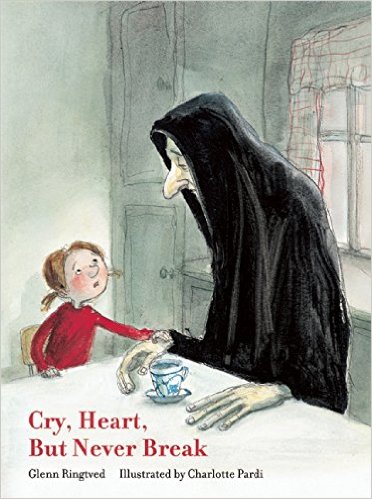
I do wonder if it’s a particularly American instinct to recommend this book of gentle death doing his job to older kids. It’s entirely possible that it its native Denmark this book is given to three-year-olds regularly. It’s all about the cultural construction, isn’t it? By the way – this marks the third time this book has appeared on one of my lists. That may be a record for this series (here are lists one and two).
Ideas Are All Around by Philip C. Stead

Ah ha! It took a while but eventually this book ended up on this list! I truly do feel that of all the picture books of this year, this is the most divisive. People who love it, adore it. People who dislike it, loathe it. Me? I like it. But I do feel it’s meant for older kids, and maybe even teens. A quiet, contemplative, fascinating work.
Kiviuq and the Mermaids by Noel McDermott, ill. Toma Feizo Gas
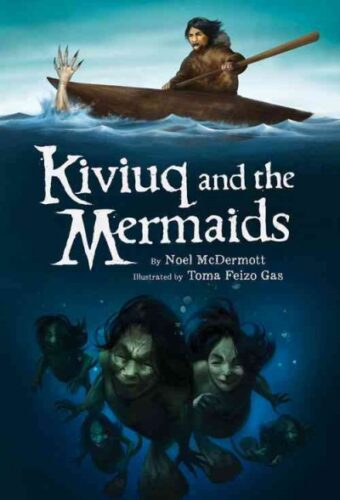
With a name like that, you’d be forgiven for at first thinking it’s some ootsy cutesy mermaid tale. It ain’t. The mermaids in this book are utterly grotesque and fascinating. They play with poor Kiviuq like cats with mice, and I love how the whole trouble begins because of a young one at the story’s start. Mermaid horror for Goosebumps-loving kids.
Lucy by Randy Cecil

Aww. I still haven’t decided if I should put this book on my early chapter list or not. Ultimately I don’t think I will, but it’s not exactly your average picture book either. This tale of a little dog that lost her loving home and is on the cusp of entering another is quiet and sweet and just right for the kid willing to wait it out.
Missing Nimama by Melanie Florence, ill. Francois Thisdale
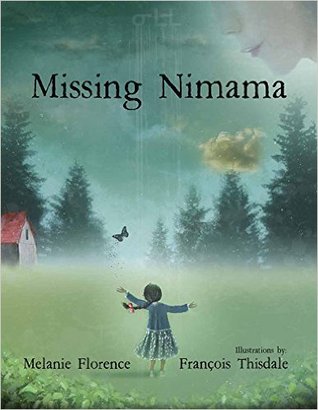
As an American I am ashamed to admit that I was completely unaware of the fact that a great many indigenous women and girls have been going missing for a number of years in Canada. You can read an interview with Melanie Florence and Francois Thisdale about the situation and how they’ve brought it to light with this book. In the story, a Cree girl must grow up without her mother, and the author goes through the years and the simple fact of how hard it is to move on when you just don’t know what has happened.
The Riddlemaster by Kevin Crossley-Holland, ill. Stephane Jorisch

Do you remember Crossley-Holland’s Arthur trilogy from a decade or two back? It was quite the big deal when I started working as a children’s librarian, though it’s faded from the public consciousness quite a bit since then. I was thrilled to find some smart editor had paired the author with the urbane and delightful Stephane Jorisch. There’s an undercurrent of fear to The Riddlemaster, but I loved the old-fashioned riddling of it all. It’s also a beauty to look at.
Rules of the House by Mac Barnett, ill. Matt Myers
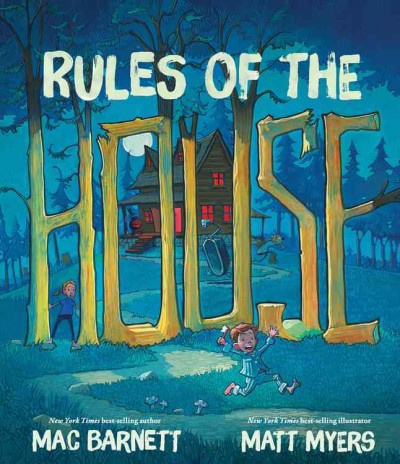
And speaking of undercurrents of fear! I was a bit surprised to find that Mac and Matt’s latest is as scary as it is. It gets its spooks legitimately, though. When someone tells you not to go through a certain door, don’t do it! Did Bluebeard teach us nothing?
Why Am I Here? by Constance Orbeck-Nilssen, ill. Akin Duzakin

You know, some years you get just a ton of philosophical picture books. Other years the numbers decrease a bit. I love the dreamy quality of this book and the big questions it’s unafraid to ask. I just don’t have any answers for it.
Interested in the other lists of the month? Here’s the schedule so that you can keep checking back:
December 1 – Board Books
December 2 – Board Book Adaptations
December 3 – Nursery Rhymes
December 4 – Picture Book Readalouds
December 5 – Rhyming Picture Books
December 6 – Alphabet Books
December 7 – Funny Picture Books
December 8 – Calde-Nots
December 9 – Picture Book Reprints
December 10 – Math Picture Books
December 11 – Bilingual Books
December 12 – International Imports
December 13 – Books with a Message
December 14 – Fabulous Photography
December 15 – Fairy Tales / Folktales
December 16 – Oddest Books of the Year
December 17 – Older Picture Books
December 18 – Easy Books
December 19 – Early Chapter Books
December 20 – Graphic Novels
December 21 – Poetry
December 22 – Fictionalized Nonfiction
December 23 – American History
December 24 – Science & Nature Books
December 25 – Transcendent Holiday Titles
December 26 – Unique Biographies
December 27 – Nonfiction Picture Books
December 28 – Nonfiction Chapter Books
December 29 – Novel Reprints
December 30 – Novels
December 31 – Picture Books

What is a Child? Beatrice Alemagna. 2016. Tate. 36 pages. [Source: Review copy]
First sentence: A child is a small person. They are only small for a little while, then they grow up. They grow without even thinking about it. Slowly and silently, their body grows taller. A child is not a child forever. One day, they change.
Premise/plot: "What is a Child?" That is the question asked and answered by author, Beatrice Alemagna. Her answers are thoughtful, and, at times poetic. She definitely takes the question seriously.
My thoughts: I really found myself loving the text. Here's a phrase that caught me: "The children who decide not to grow up will never grow up. They keep a mystery inside them." And another, "Children want to be listened to with eyes wide open."
While I loved the text, I didn't love the illustrations.
Text: 5 out of 5
Illustrations: 2 out of 5
Total: 7 out of 10
© 2016 Becky Laney of
Becky's Book Reviews
A Child of Books. Oliver Jeffers. 2016. Candlewick Press. 40 pages. [Source: Review copy]
First sentence: I am a child of books. I come from a world of stories and upon my imagination I float.
Premise/plot: Books are celebrated in Oliver Jeffers' newest picture book. The illustrations are both simple and complex. Many illustrations feature a young girl and boy. Most pages also feature illustrations crafted out of the text of many, many books. For example, a path is created using the text of Alice's Adventures in Wonderland. Or a mountain is created using the text of Peter Pan and Wendy. Or tree branches are created using the text of several fairy tales. Each two-page spread is well-worth an adult's time.
My thoughts: I really liked this one. The narrative itself is beautiful, definitely poetic. I think the narrative is simple enough that it could work as a read aloud for almost any age. (Well, maybe not babies and toddlers and preschoolers with almost nonexistent attention spans.) The illustrations add a lot of depth and complexity. This element would probably be lost for a group read aloud, but, perhaps preserved in reading one on one with a child. Adults could definitely spend a LOT of time looking carefully at every single page. If you've read a lot, you may recognize phrases from the illustrations that 'jump' out at you.
Text: 5 out of 5
Illustrations: 4 out of 5
Total: 9 out of 10
© 2016 Becky Laney of
Becky's Book Reviews
Fascinating: The Life of Leonard Nimoy. Richard Michelson. Illustrated by Edel Rodriguez. 2016. 40 pages. [Source: Review copy]
First sentence: Lenny took a deep breath and looked out at the playhouse stage.
Premise/plot: Richard Michelson has written a picture book biography of Leonard Nimoy. The book opens in 1939 with a young Lenny preparing to sing "God Bless America" at a talent show. He was the son of Russian immigrants--Jewish, and raised so. In fact, his inspiration for the Vulcan hand gesture--live long and prosper--came from a priestly blessing.
Readers learn about his interest in photography and acting. Both would be life-long pursuits and interests.
The book closes with Leonard Nimoy taking on the role of Spock and making it truly his own. The last illustrated spread depicts the first use of the "live long and prosper" from the episode Amok Time.
The next two pages fill out the rest of his life. He was an actor and a director. He was a photographer who displayed his photographs for the public, and, in fact published them as works of art. He was also an author.
The end brings a smile to my face. Before he left home, his mother encouraged him to learn to play the accordion. Acting jobs may come and go, she warned. But musicians can find a way to work. The book ends, "But he never did learn to play the accordion."
My thoughts: I LOVED this one so much. I thought it was very charming and well written. I did indeed find it fascinating. The author's note was great. I love that this book was written by one of Leonard Nimoy's close friends. I loved the personal touch--knowing that Nimoy read and approved of the project.
Text: 5 out of 5
Illustrations: 5 out of 5
Total: 10 out of 10
© 2016 Becky Laney of
Becky's Book Reviews
B is for Big Ben. Pamela Duncan Edwards. 2016. 32 pages. [Source: Library]
First sentence: A is for the Anglo-Saxons...
Premise/plot: The book is an alphabet book for a much, much older audience. The "main" narrative perhaps is simple enough that it could be read aloud to elementary students. But each page has paragraphs of side text that are weighty indeed. This information would not be of interest to say, first graders or second graders, and perhaps even of limited appeal to older children, say fourth and fifth graders. Emphasis on limited: there will always be readers--no matter their age--who do love HISTORY and are interested in CULTURE.
My thoughts: Well, I really wanted to love this one. I did. I didn't dislike it by any means. I preferred the weighty "side" text that is packed with a LOT of information. I was not overly impressed by the alphabet side of it. For example, "F is for Famous Folk." It goes on in poetic form to add: "There have been many famous people from England through the years--many artists, poets, and writers, scientists, and engineers." Now in the aside, readers learn about Jane Austen, Charles Dickens, Charles Kingsley, William Wordsworth, Beatrix Potter, Winston Churchill, Florence Nightingale, Emmeline Pankhurst, Charles Darwin, Isaac Newton, Margaret Thatcher, Queen Victoria, and Robert Scott.
Some of the choices seemed both random and generic. (For example: "Historic Sites" and "Famous Folk." Others seem to be specific and meaningful. (For example, "London," "Guy Fawkes," "Domesday Book," "William Shakespeare," and "Union Jack.")
I found it very informative. But I'm not sure how kids would really respond to it.
Text: 3 out of 5
Illustrations: 4 out of 5
Total: 7 out of 10
© 2016 Becky Laney of
Becky's Book Reviews
Shrunken Treasures. Scott Nash. 2016. Candlewick. 40 pages. [Source: Review copy]
Love picture books? Love literature? Love the idea of loving literature? Shrunken Treasures might be just right for you. Here's why: Scott Nash has condensed nine literary works into verse 'for children.' (I'm not absolutely convinced that this one is truly for children, and that it will be appreciated by children.) Am I convinced that it can and will be appreciated by adults? It's much easier to say YES to that one.
So which books are condensed?
- The Odyssey
- Frankenstein
- Moby-Dick
- Jane Eyre
- A Thousand and One Nights
- Hamlet
- Don Quixote
- The Metamorphosis
- Remembrance of Things Past
I believe two of these can be sung to nursery rhyme tunes. Not all were written with singing in mind. The shortest of the condensed works is Remembrance of Things Past.
How "useful" are these condensed stories? (I mean "useful" for students wanting to avoid reading the originals for their school assignments.) Not very! But I'm not complaining about that...at all. Hamlet, for example, is about a dog--a Great Dane--with a habit of digging holes. A Thousand and One Nights stars a tiger and a mouse. Don Quixote covers about one or possibly two chapters of a very, very long novel.
I enjoyed this one. I didn't love, love, love it. I think one thing that kept me from loving it was the fact that I didn't really "like" the illustrations.
© 2016 Becky Laney of
Becky's Book Reviews
The Wildest Race Ever. Meghan McCarthy. 2016. Simon & Schuster. 48 pages. [Source: Library]
First sentence: The first Olympic marathon held in America happened on August 30, 1904, in Saint Louis, Missouri.
Premise/plot: This nonfiction picture book tells the wild-but-true story of the first Olympic marathon. McCarthy introduces us to ten runners out of the thirty-two that started the race. This story has plenty of twists and turns. It's never dull!
My thoughts: I really enjoyed this one. It appears to be well-researched. A select bibliography is included. And a link is provided for a full bibliography. It is well-written in my opinion! The story is lively and fun. I really liked the end papers!
It is probably best suited for slightly older readers. (Elementary perhaps instead of preschool.) It might make for a slightly awkward group read-aloud because there are a lot of sidebars and such in addition to the main narrative.
Text: 5 out of 5
Illustrations: 3 out of 5
Total: 8 out of 10
© 2016 Becky Laney of
Becky's Book Reviews
The Grand Mosque of Paris: A Story of How Muslims Saved Jews During the Holocaust. Karen Gray Ruelle. Illustrated by Deborah Durland DeSaix. 2009. Holiday House. 40 pages. [Source: Library]
First sentence: In 1940 war came to Paris, and life was turned upside down.
Premise/plot: Quite simply this is a picture book for older readers. Dare I say it's even a picture book primarily for adults?! This picture book is definitely text-heavy, and the subject is a heavy one. The book brings to light something you may not know: the North African Muslims of Paris rescued a lot of Jews during World War II. (Others were part of the French Resistance.)
This is not a well-documented, well-known part of history. Rescuing Jews (hiding Jews, creating new identity papers, forging documents, smuggling them out of France) was deadly dangerous. So it makes sense that it was not well-documented, that they did not leave a paper trail to show how many hundreds or thousands they rescued during the war. This is a story of what we do know--a handful of cases, examples, of men, women, and children rescued by Muslims.
My thoughts: This one is packed with information, most of it all new-to-me. Because I am interested in the subject, I found it fascinating. It isn't a storytelling narrative. The text doesn't thrill you with its beauty. But it is dense with information that you probably can't find elsewhere. I can guess why they went with a picture book format. The illustrations are LOVELY and truly complement the text.
Text: 3 out of 5
Illustrations: 4 out of 5
Total: 7 out of 10
© 2016 Becky Laney of
Becky's Book Reviews
Aaron and Alexander: The Most Famous Duel in American History. Don Brown. 2015. 32 pages. [Source: Library]
First sentence: Aaron and Alexander could have been friends. They were alike in many ways. But the ways in which they were different made them the worst of enemies.
Premise/plot: Don Brown compares and contrasts the lives of two men--two patriots--Aaron Burr and Alexander Hamilton. The book does a great job in providing context for the now-more-famous-than-ever duel between Burr and Hamilton. The narrative is straight-forward and engaging.
My thoughts: I definitely liked it. I can say I like the narrative more than the illustrations. I thought the narrative was good and age-appropriate.
Is it text-heavy? Not really. I'd say it was very well balanced actually. It is still for older readers. (I don't imagine anyone reading this one out to kindergartners or first graders.) I'd say it's for the 9 to 99 crowd.
Text: 4 out of 5
Illustrations: 3 out of 5
Total: 7 out of 10
© 2016 Becky Laney of
Becky's Book Reviews
Duel: Burr and Hamilton's Deadly War of Words. Dennis Brindell Fradin. Illustrated by Larry Day. 2008. Walker. 40 pages. [Source: Library]
First sentence: The two enemies had much in common, starting with difficult childhoods.
Premise/plot: A picture book biography focusing on the lives of two founding fathers, Aaron Burr and Alexander Hamilton. The book slowly but surely builds its way towards the DUEL between the two men; the duel that will end the life of one and ruin the career of the other. As part of the context for understanding the duel, a little bit of American history is unpacked for readers, highlighting the roles both men had during American's war for independence and the turbulent decades afterwards as the United States of America came into existence. The book illustrates that politics always involves DRAMA.
My thoughts: I liked this one. I really do. I think it is definitely a picture book for older readers though. Not all picture books are intended as fun readalouds for preschoolers and kindergartners. The text keeps the story moving--it's quite lively at times. The author notes that both men were to blame for the duel.
I definitely liked the illustrations by Larry Day.
Text: 4 out of 5
Illustrations: 4 out of 5
Total: 8 out of 10
© 2016 Becky Laney of
Becky's Book Reviews

By:
Becky Laney,
on 5/9/2016
Blog:
Becky's Book Reviews
(
Login to Add to MyJacketFlap)
JacketFlap tags:
books reviewed in 2016,
biography,
picture books,
picture books for older readers,
j nonfiction,
Houghton Mifflin Harcourt,
review copy,
2016,
2016 Cybils-Eligible,
Add a tag
Nadia: The Girl Who Couldn't Sit Still. Karlin Gray. Illustrated by Christine Davenier. 2016. HMH. 40 pages. [Source: Review copy]
Premise/plot: A picture book biography of Nadia Comaneci.
My thoughts: First, I just want to say that I want--no, I NEED--more picture books about gymnastics. Or early readers. Or chapter books. Or, you know, novels. And while I'm at it, I'll put in a request for books about ice skating. A picture book about the 1996 U.S. Gymnastics team would be GREAT fun I think!
Second, I just have to say that I really enjoyed this picture book biography of Nadia Comaneci! It is a very age-appropriate biography I must say. It is set in Romania in the 1960s and 1970s. (But the focus is never on politics or hardships or possible reasons why she might have defected from her country.) Readers meet a young Nadia and her coaches Bela and Marta Karolyi. She began doing gymnastics at the age of 6. Over half the book focuses on the 1976 Olympic Games. The book ends with her returning home after winning at the Olympics. She was 14 years old, I believe. I want to say that these days you have to be at least sixteen in order to compete at the Olympics. A timeline will catch adults up on her life story.
One thing I did appreciate was the source notes provided at the end of the book. So often picture book biographies fail to show their research.
This one is easy to recommend.
Text: 5 out of 5
Illustrations: 3 out of 5
Total: 8 out of 10
© 2016 Becky Laney of
Becky's Book Reviews
A selection of darkly funny, mostly cautionary picture books.
Share these funny gems with slightly older listeners who have a sense of humor; but spare your very timid or gentle-hearted ones - happily-ever-after is not guaranteed in these tales of comeuppance, justice served, just desserts, and cautionary advice.
If you're unable to view the slide show, visit it on Riffle Books [ https://www.rifflebooks.com/list/206136] where I occasionally create themed slide shows.
Books included in the list:
- A Hungry Lion, Or a Dwindling Assortment of Animals by Lucy Ruth Cummins
- How to be Famous by Michal Shaley
- Everyone Love Bacon by Kelly DiPucchio
- Jim: Who Ran Away from his Nurse and Was Eaten by a Lion by HIlaire Belloc
- This is Not My Hat by Jon Klassen
- I Want My Hat Back by Jon Klassen
- The Book that Eats People by John Perry


By:
Becky Laney,
on 4/5/2016
Blog:
Becky's Book Reviews
(
Login to Add to MyJacketFlap)
JacketFlap tags:
war,
picture books,
dogs,
World War II,
picture books for older readers,
Charlesbridge,
library book,
2016,
2016 Cybils-Eligible,
books reviewed in 2016,
Add a tag
War Dogs. Kathryn Selbert. 2016. [April 2016] Charlesbridge. 48 pages. [Source: Library]
First sentence:
Rufus's best friend, Winston Churchill, is a busy man, but most days Rufus and Winston share a walk.Premise/plot: Essentially, War Dogs is a picture book biography of Winston Churchill during the Second World War told from the point of view of his poodle, Rufus. The book has plenty of Churchill quotes throughout. These are set apart from the main text, and are easily identifiable. One of the quotes is:
The road to victory may not be so long as we we expect. But we have no right to count upon this. Be it long or short, rough or smooth, we mean to reach our journey's end. August 1940
My thoughts: I loved, loved, loved, LOVED this one. War Dogs would definitely be more of a picture book for older readers than a story you'd share aloud with preschoolers. But. I think picture books for older readers are important and necessary, and can be quite LOVELY. I do think that picture books can be for everyone--people for all ages. So I'd definitely recommend this one. It would be a great introduction--picture book introduction--to the Second World War, and to Winston Churchill in particular. So if you're a history lover or a dog lover, you should definitely consider picking this one up!!!
I love the text. I love the illustrations. I love how each quote is sourced. Not all picture book biographies show their work when it comes to research. This one does! (Can you tell that I tend to love research myself!)
Text: 5 out of 5
Illustrations: 4 out of 5
Total: 9 out of 10
© 2016 Becky Laney of
Becky's Book Reviews
Beatrix Potter and the Unfortunate Tale of a Borrowed Guinea Pig. Deborah Hopkinson. Illustrated by Charlotte Voake. 2016. Random House. 44 pages. [Source: Library]
First sentence: My dear reader, this is a story about a girl named Beatrix Potter and what happened when she borrowed her neighbor's guinea pig.
Premise/plot: As an adult, Beatrix Potter borrowed a guinea pig from one of her neighbors. She wanted, of course, to draw it. Unfortunately, it died while in her care. In this picture book, Beatrix Potter is a child when she borrows it. Instead of returning a live guinea pig, she "returns" a sketch, a drawing of it to the neighbor. The book concludes with the "fun" fact that one of Beatrix Potter's sketches--one of a guinea pig, possibly done around the same time as this story--recently sold at auction for a lot of money.
My thoughts: Is this a children's book, really?! I would make the distinction that this picture book is best shared with older readers, perhaps mid-to-upper elementary students. I don't think it would work for younger audiences. "Gather round, everybody, let's read a story about a guinea pig that dies!!!" I am fond of Beatrix Potter's own books. Some I love. Some I like. One or two genuinely puzzle me. The contents of this one would make a great author's note. When I was reading The Complete Tales of Beatrix Potter, each story had a biographical sketch about when it was written, and what was going on in the author's life and such. This story would be great in a book like that. Or in a book for adults perhaps showcasing sketches, drawings, illustrations that never quite made it into a published book.
Text: 3 out of 5
Illustrations: 3 out of 5
Total: 6 out of 10
© 2016 Becky Laney of
Becky's Book Reviews
 Will's Words: How William Shakespeare Changed the Way You Talk by Jane Sutcliffe. Illustrated by John Shelly. 2016, Charlesbridge.
Will's Words: How William Shakespeare Changed the Way You Talk by Jane Sutcliffe. Illustrated by John Shelly. 2016, Charlesbridge.
According to author Jane Sutcliffe's note, she intended to write a book about the Globe Theater and its famous playwright, but found she was more interested in the way that William Shakespeare's words (even the invented ones!) have become so ingrained in our everyday speech.
The end result is somewhat of a hybrid. Two types of text boxes are placed upon each double-spread, full-bleed illustration. One contains an account of life in the time and milieu of William Shakespeare,
Good plays need good playwrights. And the most brilliant playwright in London was Mr. William Shakespeare. From butchers and bakers, to lords and ladies, everyone looked forward to the excitement of a Will Shakespeare play.
While the other explains one or more of Shakespeare's words,
WILL'S WORD: Excitement
WHAT IT MEANS: A feeling of "Bring it on!" This was a fairly new word in Will's time. He helped people get excited about "excitement."
WHERE IT COMES FROM: HAMLET, ACT 4, SCENE 4. There's a lot of excitement in Hamlet's family. And not the good kind.
The "Will's Word" text boxes are displayed on a facsimile of parchment paper - a nice touch. If John Shelley's illustrations don't necessarily capture the squalor of the time, they certainly capture the essence of living in a seething mass of humanity. The pen, ink, and watercolor illustrations are positively teeming with activity - providing opportunity for exploring hundreds of small details in each scene.
I chose to highlight one of the shorter passages. However, there are more than fifteen scenes packed with information presented in a lively, conversational tone that will keep readers' attention. Teachers should love this one.
The book goes on sale today. Look for it on a library shelf soon. If you choose to purchase it, you will receive the gift of more words from Shakespeare, your "
money's worth."
Author's Notes, Timeline, and Bibliography are included.
Note:
My copy of
Will's Words was provided by the publisher at my request.

Finding Winnie: The True Story of the World's Most Famous Bear. Lindsay Mattick. Illustrated by Sophie Blackall. 2015. Little, Brown. 56 pages. [Source: Library]
First sentence: "Could you tell me a story?" asked Cole.
Premise/plot: Cole, the author's young son, asks for a story--a TRUE story; he wants a true story about a BEAR. What the author shares with her son--in the story--and with readers--in the book--is indeed a true story. The story of how a young soldier on his way to war--the author's great-great grandfather finds a bear at a train station, buys it, and takes it with him. The bear's name is WINNIE. And when Harry Colebourn goes to the front, he leaves Winnie in the London Zoo. Many people loved going to see Winnie, but, the best known perhaps is A.A. Milne's young son.
My thoughts: I love several things about this one. I love the personal connection. The author is sharing her own family history with readers. Older readers may enjoy looking at the album at the back of the book. Many photos and captions are included. This grounds the book very well as being a TRUE story. It brings the story to life.
But I also enjoy the framework of this one. It is a book that celebrates storytelling and families. I believe it is a bedtime story he's asking for. I love the idea of parents sharing their own stories with children, and true stories at that! Throughout the story, readers hear the mother and son chatting. It works.
I also just genuinely love the writing of this one!
Text: 5 out of 5
Illustrations: 5 out of 5
Total: 10 out of 10
© 2016 Becky Laney of
Becky's Book Reviews
Last Stop on Market Street. Matt de la Pena. Illustrated by Christian Robinson. 2015. 32 pages. [Source: Library]
First sentence: CJ pushed through the church doors, skipped down the steps. The outside air smelled like freedom, but it also smelled like rain, which freckled CJ's shirt and dripped down his nose.
Premise: CJ and his Nana enjoy a bus ride after church; readers are led to believe that this is a frequent occurrence for the pair. But what is the last stop on Market Street?! That mystery is not revealed immediately. Readers instead are part of the journey page by page. CJ's conversation with Nana reveals a worldview of sorts that is admirable in every way.
My thoughts: How I wish I'd read this one BEFORE it won the Newbery! It also earned a Caldecott Honor. Both are deserved, in my opinion. But one is more surprising than the other, of course. Not many picture books get the Newbery medal. This isn't the first, and, it probably won't be the last. But still--it's rare.
Why do I wish I'd read it before the big announcement? Well. Once a book wins the Newbery, it seems my expectations go over-the-top. I'm "robbed" of reading the book on its own merits without the burden of comparing and contrasting it with every other Newbery winner I've read. It's not that I intentionally set out to do so. No, it's something I try to refrain from doing when I notice it. But expectations can be sneaky.
So what do I think of this one? Well, at the very, very least I really like it. I can honestly say that I love, love, love the character of Nana! Nana and CJ are a cute pair, and, the dialogue between the two which takes up almost all of the book is well worth reading several times. The first time through you might be caught up in plot to notice the little things, the tiny things, the small elements that when seen as a whole are lovely and delightful. Such as the opening description.
Text: 4 out of 5
Illustrations: 4 out of 5
Total: 8 out of 10
© 2016 Becky Laney of
Becky's Book Reviews
Trombone Shorty. Troy Andrews. Illustrated by Bryan Collier. 2015. Harry N. Abrams. 40 pages. [Source: Library]
Trombone Shorty is a picture book biography of Troy "Trombone Shorty" Andrews, a jazz musician from New Orleans. It is illustrated by Bryan Collier. Perhaps I should say BEAUTIFULLY illustrated by Bryan Collier. I have a weakness for illustrations this beautiful. I do. I can't help it.
I also tend to read picture book biographies of jazz musicians. If you read a lot of picture books, you know that there are new ones every year. If you don't read a lot of picture books, well, you might just be surprised at how many picture books are biographies of musicians past and present--not just jazz musicians, but all sorts of musicians. I'm not sure why, but, I think it is perhaps because picture books lend themselves so very well to rhythm and rhyme.
So did I enjoy this picture book? Yes! Very much. I loved the illustrations, as I've mentioned. And I love the focus on mentoring and legacies and heritage. One of the points the author stresses is that musicians help younger musicians, they should help younger musicians. They can teach; they can inspire; they can provide opportunities. He was helped along from a very young age. And this picture book pays tribute to those who helped him, who influenced him, who guided him. The author's note also mentions how he is eager to do the same for a new generation of musicians.
This one is definitely easy to recommend.
© 2016 Becky Laney of
Becky's Book Reviews
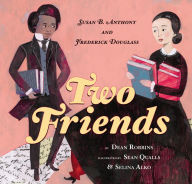
Two Friends: Susan B. Anthony and Frederick Douglass. 2016. Dean Robbins. Illustrated by Sean Qualls and Selina Alko. 2016. Scholastic. 32 pages. [Source: Review copy]
First sentence: Susan B. Anthony set out two saucers, two cups, and two slices of cake. Frederick Douglass arrived for tea.
Premise/plot: Susan B. Anthony and Frederick Douglass were friends. This picture book for older readers imagines these two sitting down and enjoying tea together. Readers learn facts about Susan B. Anthony and facts about Frederick Douglass. Readers can see what these two had in common and why they supported one another.
My thoughts: I liked it. This one reminded me of last year's Chasing Freedom by Nikki Grimes. But I happened to like this one a bit better. Instead of trying to force all the biographical facts into dialogue, this book devotes a few pages per person. Readers still learn a little bit about each one. But it doesn't feel as forced perhaps, at least in my opinion. This one was also not as text-heavy.
Text: 4 out of 5
Illustrations: 4 out of 5
Total: 8 out of 10
© 2016 Becky Laney of
Becky's Book Reviews

By:
Becky Laney,
on 12/5/2015
Blog:
Becky's Book Reviews
(
Login to Add to MyJacketFlap)
JacketFlap tags:
picture books,
Dr. Seuss,
Random House,
picture books for older readers,
children's classic,
1990,
library book,
books reviewed in 2015,
books reread in 2015,
Add a tag
Oh, the Places You'll Go. Dr. Seuss. 1990. Random House. 44 pages. [Source: Library]
First sentence: Congratulations! Today is your day. You're off to Great Places! You're off and away!
Premise/plot: I'd describe Oh, The Places You'll Go as a motivational picture book for older readers. Not that young children don't need motivation, but, the advice, in my opinion, makes more sense for older readers--grown ups even.
You are the you of the title. The whole book is written in second person.
My thoughts: I like this one. Do I love, love, LOVE it. I wouldn't get that carried away. But I do genuinely like it. I like how it's motivational and uplifting all the while being true-to-life and realistic.
Wherever you fly, you'll be best of the best. Wherever you go, you will top all the rest. Except when you don't. Because, sometimes you won't. I'm sorry to say so but, sadly, it's true that Bang-ups and Hang-ups can happen to you. You can get all hung up in a prickle-ly perch.
Have you read Oh, The Places You'll Go! Did you like it? love it? hate it? I'd love to know what you thought of it!
If you'd like to join me in reading or rereading Dr. Seuss (chronologically) I'd love to have you join me! The next book I'll be reviewing is Daisy-Head Mayzie and My Many Colored Days. I'll be doubling up for the rest of the year each Saturday.
© 2015 Becky Laney of
Becky's Book Reviews
Can't You Make Them Behave, King George? Jean Fritz. Illustrated by Tomie dePaola. 1977/1996. 48 pages. [Source: Library]
I am so glad I read Jean Fritz's Can't You Make Them Behave, King George? I found this one to be a delight. And not just because I happen to
love Horrible Histories' Born 2 Rule. (I should probably make that love, love, love, LOVE. I love Horrible Histories, the show in general, and the songs very, very much.) I've almost always enjoyed studying British literature and British history more than American. Though in the case of this book, you get a bit of both!
Can't You Make Them Behave, King George? is about the reign of George III. How he came to the throne, what kind of king he was, what he was remembered for, etc. A lot of the focus is on the conflict, the war, with the American colonies. But it isn't just about the American Revolution either. Plenty of attention is placed on the royal family which I loved.
This biography is definitely for mid-to-upper elementary students. A good read aloud for first grade it isn't! There is a lot of text per page, but, there are also plenty of illustrations. And the illustrations are by Tomie dePaola. Some are in color, others are in black and white. But the important thing is that there are illustrations. I've mentioned it before, but, it's worth repeating. When I had to choose a nonfiction book for report, required reading, I decided which book based on the length and the number of illustrations. This one would have been well received by me!
I read a reprint edition that came out circa 2009. It was originally published in 1977.
© 2015 Becky Laney of
Becky's Book Reviews
The Only Child. Guojing. 2015. Random House. 112 pages. [Source: Review copy]
First sentence from the author's note: The story in this book is fantasy, but it reflects the very real feelings of isolation and loneliness I experienced growing up in the 1980s under the one-child policy in China.
Premise/plot: This is a wordless picture book. I'm tempted to call this one a picture book for older readers. Though I'm not sure that's entirely fair to the book. It may depend more on your child's attention span and interests. The art is without a doubt captivating and beautiful. The premise is simple: a young girl's loneliness ultimately leads to her getting lost. At some point, reality blends with fantasy. Where is that point exactly??? I'm not sure I can answer that!
My thoughts: Loved, loved, loved the art. It does a great job in conveying emotion, for the most part. I tend to struggle with finding the story in wordless picture books at times. The more complex a book is, the more I struggle. Ultimately I found The Only Child to be worth the effort it took to find and follow the story. But that being said, I'm not sure I fully got every page of the story. Still it's easy to recommend for the art alone.
Text 0 out of 0
Illustrations: 5 out of 5
Total: 5 out of 5
© 2015 Becky Laney of
Becky's Book Reviews
View Next 25 Posts



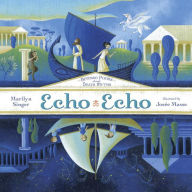

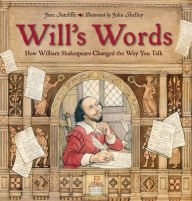










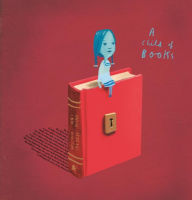



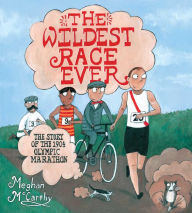





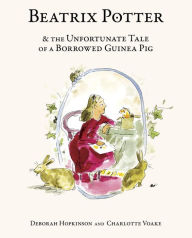
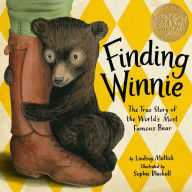
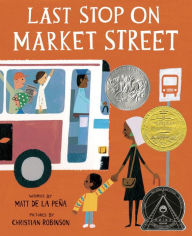



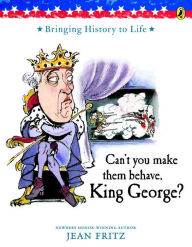
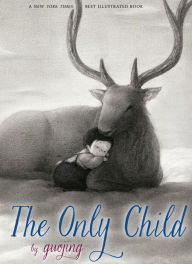
What a wonderful way to introduce young people to Shakespeare! Through phrases they still hear and use every day.